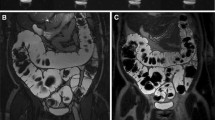Abstract
The aim of our study was to assess the effect of oral and rectal stool softeners on dark-lumen magnetic resonance (MR) colonography without bowel cleansing. Ten volunteers underwent MR colonography without colonic cleansing. A baseline examination was performed without oral or rectal administration of stool softeners. In a second set, volunteers ingested 60 ml of lactulose 24 h prior to MR examination. In a third examination, water as a rectal enema was replaced by a solution of 0.5%-docusate sodium (DS). A fourth MR examination was performed, in conjunction with both oral administration of lactulose and rectal application of DS. A T1-weighted data set was acquired at scanning times of 0, 5 and 10 min after colonic filling. A fourth data set was acquired 75 s after i.v. injection of contrast agent. Signal intensity of stool was calculated for all colonic segments. Without oral ingestion of lactulose or rectal enema with DS stool signal intensity was high and did not decrease over time. However, lactulose and DS caused a decrease in stool signal intensity. Both substances together led to a decreasing signal intensity of feces. Combination of lactulose and DS provided the lowest signal intensity of stool. Thus, feces could hardly be distinguished from dark rectal enema allowing for the assessment of the colonic wall.







Similar content being viewed by others
References
Neuhaus H (1999) Screening for colorectal cancer in Germany: guidelines and reality. Endoscopy 31:468–470
Landis SH, Murray T, Bodden S , Wingo PA (1998) Cancer statistics, 1998. CA Cancer J Clin 48:6–29
O’Brien MJ, Winawer SJ, Zauber AG et al (1990) The national polyp study. Patient and polyp characteristics associated with high-grade dysplasia in colorectal adenomas. Gastroenterology 98:371–379
Liebermann DA, Smith FW (1991) Screening for colon malignancy with colonoscopy. Am J Gastroenterol 86:946–951
Fiocca R, Ceppa P (2003) The diagnostic reliability of endoscopic biopsies in diagnosis colitis. J Clin Pathol 56:321–322
Nahon S, Bouhnik Y, Lavergne-Slove A et al (2002) Colonoscopy accurately predicts the anatomical severity of colonic Crohn’s disease attacks: correlation with findings from colectomy specimens. Am J Gastroenterol 12:3102–3107
Dachman AH, Kuniyoshi JK, Boyle CM et al (1998) CT colonography with three-dimensional problem solving for detection of colonic polyps. AJR Am J Roentgenol 171:989–995
Ajaj W, Pelster G, Treichel U et al (2003) Dark lumen magnetic resonance colonography: comparison with conventional colonoscopy for the detection of colorectal pathology. Gut 52:1738–1743
Matter SE, Rice PS, Campbell DR (1993) Colonic lavage solutions: plain versus flavored. Am J Gastroenterol 88:49–52
Froehlich F, Fried M, Gonvers JJ (1994) Colonic lavage: flavoring and the importance of patients’ compliance. Am J Gastroenterol 89:639–640
Lew RJ, Ginsberg GG (2002) The role of endoscopic ultrasound in inflammatory bowel disease. Gastrointest Endosc Clin N Am 3:561–571
Higaki S, Nohara H, Saitoh Y et al (2002) Increased rectal wall thickness may predict relapse in ulcerative colitis: a pilot follow-up study by ultrasonographic colonoscopy. Endoscopy 3:212–219
Lauenstein TC, Goehde SC, Ruehm SG, Holtmann G, Debatin JF (2002) MR colonography with barium-based fecal tagging: initial clinical experience. Radiology 1:248–254
Lauenstein T, Holtmann G, Schoenfelder D, Bosk S, Ruehm SG, Debatin JF (2001) MR colonography without colonic cleansing: a new strategy to improve patient acceptance. AJR Am J Roentgenol 4:823–827
Lefere PA, Gryspeerdt SS, Dewyspelaere J, Baekelandt M, Van Holsbeeck BG (2002) Dietary fecal tagging as a cleansing method before CT colonography: initial results, polyp detection and patient acceptance. Radiology 224:393–403
Bielen D, Thomeer M, Vanbeckevoort D et al (2003) Dry preparation for virtual CT colonography with fecal tagging using water-soluble contrast medium: initial results. Eur Radiol 13:453–458
Taylor SA, Halligan S, Bartram CI (2003) CT colonography: methods, pathology and pitfalls. Clin Radiol 3:179–190
Neri E, Giusti P, Battolla L et al (2002) Colorectal cancer: role of CT colonography in preoperative evaluation after incomplete colonoscopy. Radiology 3:615–619
Jamieson DH, Shipman PJ, Israel DM, Jacobson K (2003) Comparison of multidetector CT and barium studies of the small bowel: inflammatory bowel disease in children. AJR Am J Roentgenol 5:1211–1216
Goehde SC, Ajaj W, Lauenstein T, Debatin JF, Ladd ME (2004) Impact of diet on stool signal in dark lumen magnetic resonance colonography. Magn Reson Imaging 20:272–278
Borthne AS, Dormagen JB, Gjesdal KI, Storaas T, Lygren I, Geitung JT (2003) Bowel MR imaging with oral Gastrografin: an experimental study with healthy volunteers. Eur Radiol 13:100–106
Knopp MV, Giesel F, von Tengg-Kobligk H (2004) 3D MR colonography after intravenous administration of the hepatobiliary contrast agent Gd-BOPTA: bile tagging. Eur Radiol 14:O80–O83; discussion O84–O85
Ewe K, Ueberschaer B, Press AG, Kurreck C, Klump M (1995) Effect of lactose, lactulose and bisacodyl on gastrointestinal transit studied by metal detector. Aliment Pharmacol Ther 9:69–73
Merli M, Caschera M, Piat C, Pinto G, Diofebi M, Riggio O (1992) The effect of lactulose and lactitol administration on fecal fat excretion in patients with liver cirrhosis. J Clin Gastroenterol 15:125–127
Lederle FA, Busch DL, Mattox KM, West MJ, Aske DM (1990) Cost-effective treatment of constipation in the elderly: a randomized double-blind comparison of sorbitol and lactulose. Am J Med 89:597–601
Chapman RW, Sillery J, Fontana DD, Matthys C, Saunders DR (1985) Effect of oral dioctyl sodium sulfosuccinate on intake–output studies of human small and large intestine. Gastroenterology 89:489–943
Donowitz M, Binder HJ (1975) Effect of dioctyl sodium sulfosuccinate on colonic fluid and electrolyte movement. Gastroenterology 69:941–950
Hänsel R, Sticher O, Steinegger E (1999) Pharmacognosy and phytopharmacy. Springer, Berlin Heidelberg New York, pp 309–327
Author information
Authors and Affiliations
Corresponding author
Rights and permissions
About this article
Cite this article
Ajaj, W., Lauenstein, T.C., Schneemann, H. et al. Magnetic resonance colonography without bowel cleansing using oral and rectal stool softeners (fecal cracking)—a feasibility study. Eur Radiol 15, 2079–2087 (2005). https://doi.org/10.1007/s00330-005-2838-2
Received:
Revised:
Accepted:
Published:
Issue Date:
DOI: https://doi.org/10.1007/s00330-005-2838-2




